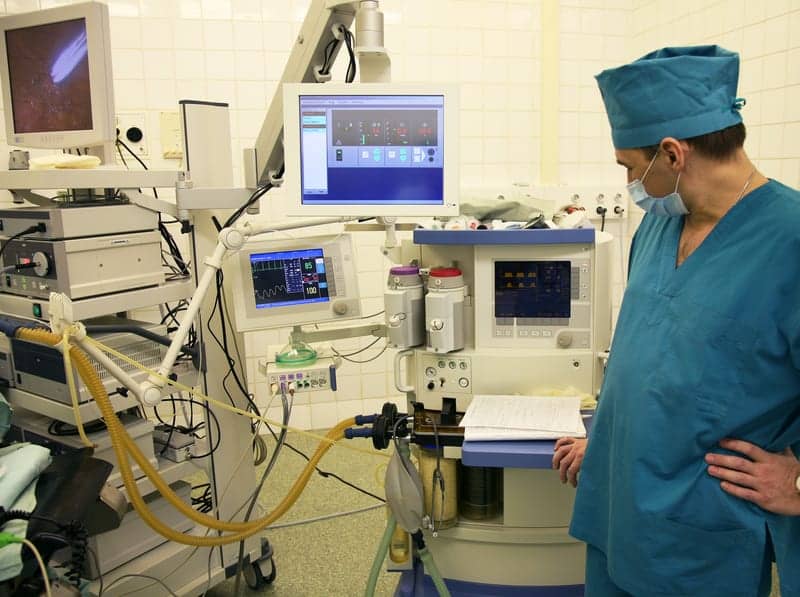By Andy Lundin
Establishing a systematic process for proper medical equipment disposition is critical for any healthcare organization that wants to appropriately handle devices that have reached their end of life.
How an organization decides to address equipment disposition boils down to a few core methods, which are primarily recycling, reselling, donating, scraping, or trading back to an original equipment manufacturer (OEM). But the decision on which direction to take should not be rushed or considered lightly.
“It is essential to correctly determine the end status of a medical device after it has been decommissioned to ensure proper management, reduce waste, and minimize the risk of harmful exposure of personnel, the public, and the environment,” according to guidance from the World Health Organization (WHO).
Ensuring that an organization considers the appropriate methods of disposition for a particular device or piece of medical equipment will ultimately help it reach a decision that not only makes the most sense for the device’s future but is also fiscally sound. Moreover, adopting a systematic approach for these procedures will streamline the entire process, experts say.
First and Foremost: Risk Mitigation
When an organization commits itself to any medical equipment disposition practice, it’s critical to ensure that proper risk mitigation procedures take place. For instance, if one resells unsanitized equipment or fails to wipe a device of electronic protected health information (ePHI), there may be repercussions for the organization.
“These are medical equipment that may have ePHI; there may be biohazards that could lead to environmental concerns, maybe there is radiation,” says Jeff Dalton, president and CEO of Twinsburg, Ohio-based ReLink Medical.
To help curb this issue, Dalton suggests medical facilities partner with a certified vendor who can help them better assess and mitigate any potential risks during disposition, such as neglecting to sanitize a device. After all, Dalton says, “It doesn’t matter how much money you get for that equipment, if you, say, get sued because you left pharmaceuticals in your anesthesia machine, you, as a hospital, might lose your pharmaceutical license.”
Tony Lively, president and owner of Oceanside, Calif.-based ZRG Medical, concurs and notes a few questions that should be asked during the equipment decommissioning process:
- Does the organization have proper release of liability documentation?
- Has the medical equipment been properly decontaminated?
- Has the device been removed from any internal database following its disposition?
- Has the ePHI data been removed properly?
Addressing ePHI in Equipment Disposition
The latter consideration—removing ePHI—is particularly relevent in the medical device sector, where cybersecurity issues are rampant.
Lively says ensuring that ePHI data is properly wiped from medical equipment is essential—although certain regulations must be followed. “When disposing of medical equipment, all requirements set by HIPAA must be followed throughout the entire process in order to avoid any violations,” he explains.
“If the device links to the patient health record and saves any patient-identifying information, the internal storage device should be removed and destroyed,” he adds. “If, for some reason, a hard drive with patient information is found after the device has been released from your facility, be sure that your third-party equipment vendor is well versed in the process for finding, removing, and destroying patient information.” The best practice, Lively says, is to document the chain of custody. Plus, he says, all retired devices should be reset to their factory defaults.
Garret Purrington, CEO of New Bedford, Mass.-based Medical Equipment Dynamics, shares Lively’s sentiment, emphasizing the importance of having signed HIPAA/ePHI documentation from an asset disposition vendor if they’re helping with disposal. That way, the vendor can recheck each device for ePHI and dispose of and sanitize equipment as necessary.
Not that this is the gold standard, Purrington cautions. “This is the bare minimum,” he says. “There are many other practices in-place today to ensure fair market value return and a significantly streamlined, much more efficient process to liquidate decommissioned assets to save the hospital and healthcare systems time and money while reducing associated risk.”
Equipment Disposition and Operational Efficiencies
While improved risk mitigation and better patient data protection are key reasons to introduce a systematic approach for medical equipment disposition, an organization will also benefit from improvements in operational efficiencies as they relate to decommissioning equipment.
For example, a medical facility without a widely integrated protocol for disposition may have inconsistencies throughout the entire medical facility and across varying departments.
“We have found that most hospitals have fragmented processes, and they have difficulty implementing system-wide processes within their organization,” says Gregory Hemphill, ReLink Medical’s senior vice president of enterprise solutions. “So, the imaging department may do something different than the surgery department, which may do something different than women’s health, and so on. We work with the hospital to really push supply chain strategies throughout the organization. That may be multiple hospitals, or it may be multiple facilities or even multiple states.”
If there isn’t a systematic disposition plan in place, health organizations might resort to making hasty, last-minute decisions regarding a piece of medical equipment that has reached the end of its life. And those hasty decisions can do more than create a liability for the organization. They can severely impact the organization’s bottom line. To avoid such issues, Garret Purrington encourages facilities to pay attention to resale values.
What’s more, without a systematic process, there can be uncertainty as to who in the organization is responsible for equipment disposition. This can impact decisions for equipment decommissioning and limit the team’s time to assess a device when it reaches the end of its life.
“Because there’s no process, they might not even know who’s responsible for disposition,” Purrington adds. “Is the purchasing team or clinical team responsible? Is it a third-party biomed’s responsibility? These questions can suddenly become significant to the organization once asset disposition needs to be addressed.”
Why the Entirety of Equipment Lifecycle Is Critical
Purrington stresses the importance of decision makers establishing a systematic process where the full lifecycle of the device—from beginning to end—is considered. “The liquidation side is the end of that lifecycle, and it potentially becomes factored into the initial request for proposal. For example, we want a proposal that includes trade-in, possibly, and then it’s part of making sure that that trade is valuable and fair to the hospital,” he says.
The fact is medical devices deteriorate after extended use—reaching a state at which the cost-benefit ratio is negative, given declining equipment performance, unreliability, and regular failure. However, as early as the point of acquisition, there can be other factors to consider that will dictate other disposition actions.
It’s something Jeff Dalton knows all too well. “When we started ReLink, the whole approach was, in some situations, you need to get rid of that equipment faster than what you expected,” he says. “And in some situations, you should hold on to that equipment based on my market indicators. So the piece of equipment really has a functionality component as well.”
Keeping It Sustainable
Another factor that can influence an organization’s disposition process is its commitment to sustainability. Consider this statistic, provided by Tony Lively: Hospitals spent an average of $83 billion on new medical equipment in 2018.
“The amount of plastics, metals, greenhouse gas emissions, and water wasted to produce these necessary, life-saving pieces of equipment is astronomical,” he says. “At ZRG Medical, we reduce the amount of waste going to the landfills and the environmental impact of medical equipment production by refurbishing and reselling the medical equipment that hospitals no longer want.”
For those medical organizations with a “green” strategy, a third-party vendor can be especially valuable in in achieving those corporate sustainability goals. As ReLink Medical’s Gregory Hemphill explains, these goals are “top of mind” for hospitals that are receiving federal income or federal reimbursements. “They have to show that they have certain green initiatives going on in their hospital,” he says.
One such sustainability practice that can have a wider impact is donating the device to medical networks in foreign countries or global humanitarian networks. Not only do the devices get a new home and continue to have an impact, but they also avoid the landfill.
“There are many third-world or developing countries that cannot afford the newest, state-of-the-art equipment,” Lively adds. “That does not mean that they should go without equipment. In fact, the equipment that we acquire from hospitals through our asset disposition services is very vital to the life-saving capabilities of these countries.” Not that this only applies to the third world, Lively asserts. “Much of the equipment that we receive, test, and repair is a great option for doctors here in the United States,” he says.
Andy Lundin is associate editor of 24×7 Magazine. Questions and comments can be directed to [email protected].
Sidebar: Donating Equipment to Global Charities
Does your organization have a medical equipment graveyard? Or equipment that has reached the end of its lifecycle in your facility? If so, donating that equipment could do a world of good.
Project C.U.R.E. is a non-profit organization that distributes donated medical supplies, equipment, and services to physicians and nurses serving the sick and dying in more than 130 countries. Currently, the organization is providing equipment to Ukraine. That aid, which is flown via air cargo, includes wound care devices and surgical instruments, according to Janet Thomason, director of national procurement at the international headquarters for Project C.U.R.E.
ReLink Medical is also facilitating medical equipment donations to countries in crisis, including Ukraine and Haiti. In the latter, the company is working with local facilities to ensure they have the equipment and support they need.
“We are going system by system and site by site to help modernize their medical equipment—not only by giving them medical equipment, but also by making sure they have a service arm [and] that they know how to use [and install the devices]. We are also making sure that they have the right power, the right technicians, and access to the right parts,” says Jeff Dalton, ReLink Medical president and CEO.
The fact is many organizations, including OEMs and healthcare facilities, have medical equipment sitting idle, and donation to charity can allow that equipment to continue to have a positive impact.
“What we need is for these manufacturers, and all the HTM professionals that are out in the field, to consider donation as an option to release their equipment,” says Thomason. “From our standpoint, what we see is a lot of what I call ‘equipment graveyards’ in hospitals. Equipment that is string on floors just in case someone needs it or [because] no one knows what to do with it.”
Thomason often finds an all-too-common scenario when visiting healthcare facilities. Two or three years after her first visit, she will find the same unused equipment still there as the facility continues to amass new equipment. Given this, she’s asking facilities to change their mindset and think about donation to help the global community served by organizations like Project C.U.R.E.
“In addition to the urgent crisis in Ukraine, many low-resourced countries are in need of medical equipment,” she says, adding that many low-resource countries are such not because they lack a surgeon, but because they lack the equipment.
—A.L.





